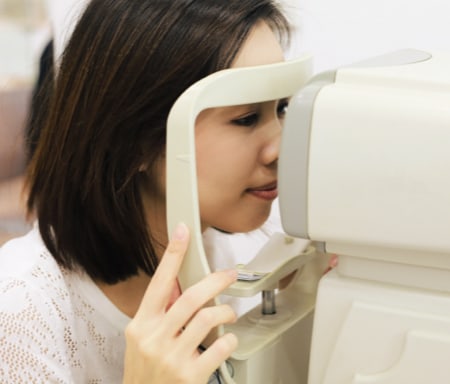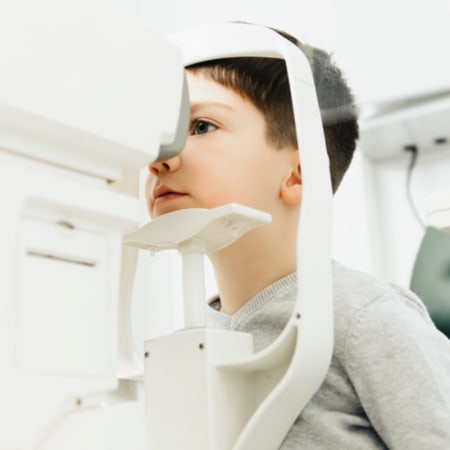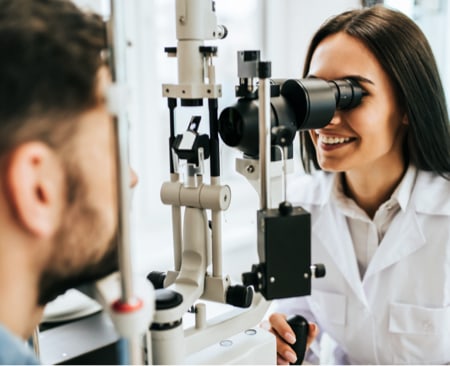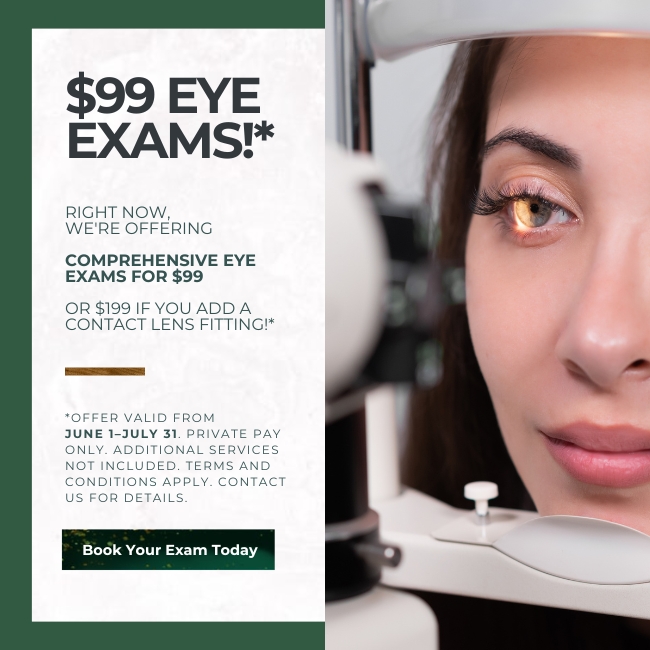Diagnosing Eye Disease
Sometimes it’s tricky to identify eye problems on your own. Our eyes are constantly looking out, but it takes a visit to your optometrist to look inside.
Eye diseases may not show obvious symptoms in their early stages, but they can develop into harmful conditions that affect your vision and overall health.
The American Optometric Association (AOA) recommends adult eye exams every 2 years and children’s eye exams every year after first grade. Your eye care team gets to know you and your unique eyes to monitor symptoms and health trends. The more information we have, the better we can help you protect your vision. Preserve your vision by booking an eye exam.

Preventing Future Issues
Many eye conditions can be effectively treated or managed with early diagnosis. During regular comprehensive eye exams, your optometrist takes a thorough look at your visual system. By discussing your eye care, including symptoms or concerns, your eye doctor can help prevent eye disease.

Common Eye Conditions
Our eyes change as we age, and so do the types of eye problems we may encounter. The eye diseases typical in children often aren’t the same as eye diseases common in adults. Each end of the spectrum is vulnerable for different reasons.
Children’s eye exams can detect eye health and vision problems, which is vital for effective treatment. Children’s most prevalent eye conditions are refractive errors, amblyopia (lazy eye), strabismus, and congenital anomalies.
Adults over 40 are at the greatest risk for eye disease. Many common eye conditions and diseases are preventable and treatable if diagnosed early. Unfortunately, they can also be hard to identify in the early stages without the help of an optometrist.
Visiting your optometrist helps you keep an eye on your ocular health, including symptoms associated with eye disease.
Glaucoma
Glaucoma is the second leading cause of blindness worldwide, and it affects more than 3 million Americans. Glaucoma damages the optic nerve, which transfers visual information from our eyes to our brain.
Glaucoma typically progresses slowly, which is why the symptoms are ignored. Vision loss begins with peripheral (outer) vision, narrowing visual ability as optic nerve cells die.
Routine eye exams are the best option for diagnosing glaucoma and preventing blindness. During an eye exam, your optometrist tests the pressure of your eye, which can indicate the risk of glaucoma.
Cataracts
Cataracts are blurry or cloudy areas that appear in the lens of the eye, typically caused by natural eye changes as we age. However, eye injuries, sun damage, family history of cataracts, diabetes, and some health conditions or medications can also cause a cataract.
Some common cataract symptoms include:
- Double vision
- Faded color vision
- Poor night vision
- Sensitivity to light
- Halos around lights
- Cloudy or blurry vision
- Frequent prescription changes
Managing symptoms can’t reverse a cataract, but it can improve comfort. Some options are prescription lenses, eye drops, or eye surgery.
Dry Eye Disease
Your eyes have a natural layer of lubrication that supports eye function, but when your tears aren’t working as they should, you may get dry eyes. Depending on the symptoms, dry eye disease can be a minor issue or a significant eye problem. If you experience symptoms, big or small, you might benefit from treatment or management, such as dry eye therapy.
Some symptoms of dry eyes include:
- Dry eyes
- Redness
- Blurry vision
- Burning eyes
- Watery eyes
- Light sensitivity
- Irritated or scratchy eyes
- Stringy eye mucus
Diabetic Eye Disease
Diabetes is a chronic condition that can cause various ocular conditions, including cataracts, glaucoma, diabetic macular edema (DME), and diabetic retinopathy.
It’s the leading cause of vision loss in adults. But most vision problems caused by diabetes are preventable. Regular diabetic eye exams can help protect vision and diagnose eye conditions before they become a problem.
Common symptoms of diabetic eye disease include:
- Vision loss
- Blurred vision
- Dark areas
- Flashes of light
- Poor color vision
Age-Related Macular Degeneration
Age-related macular degeneration (AMD) is an eye condition caused by damage to the macula, typically because of aging. The macula controls our central or straight-ahead vision. As the macula deteriorates, our central vision is weakened.
There are 2 types of AMD: dry and wet.
Dry is the more common type. It typically progresses slowly, following a gradual thinning of the macula. It contains 3 stages, early, intermediate, and late. Management and treatment options depend on the stage, with the most significant vision protection available in the early stages.
Wet progresses faster and occurs when the growth of abnormal blood vessels damages the macula. Wet AMD develops as a result of dry AMD, typically in the later stages.
The symptoms of AMD depend on the stage of degeneration but often include:
- Blurred vision
- Dark or blank spots
- Poor color vision
- Poor vision in low light
- Straight lines appearing wavy or curved
The Tech Behind Diagnosis
We use several modern diagnostic technologies to assess your ocular health at Pacific Pier Optometry.
Goldmann Applanation Tonometer
The Goldmann applanation tonometer is often considered the gold standard for testing intraocular pressure (IOP) because of its accuracy. During the test, a small probe gently presses the front of your cornea, the transparent outer layer of your eye, to measure the pressure. Elevated eye pressure can indicate eye problems, including glaucoma.
iCare
iCare diagnostic tools offer fast, noninvasive diagnostics for eye disease and eye health. iCare includes tonometers, imaging devices, and perimeter testing (visual field test).

Protect Your Vision
Diagnosing eye problems early can protect your vision and eye health. Book an appointment with your optometrist at Pacific Pier Optometry to learn more about eye disease and how we can help.
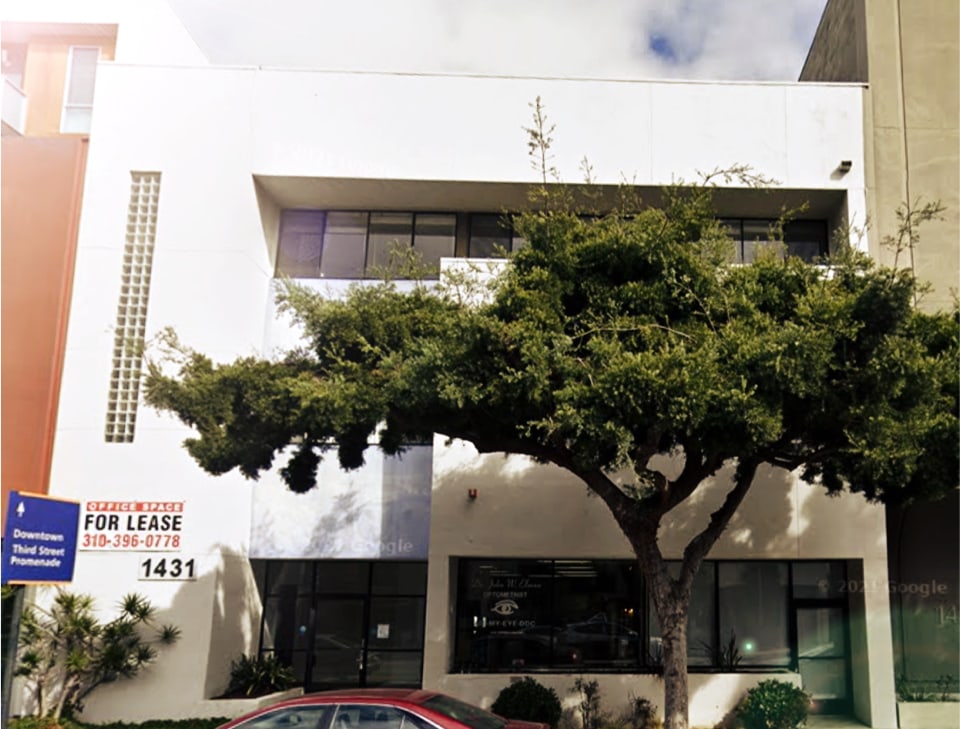
Find Us in Santa Monica
Clinic Hours
- Monday: 9:00 AM – 12:00 PM
- Tuesday: 9:00 AM – 5:00 PM
- Wednesday: 9:00 AM – 5:00 PM
- Thursday: 9:00 AM – 5:00 PM
- Friday: 9:00 AM – 5:00 PM
- Saturday: 9:00 AM – 12:00 PM
- Sunday: Closed
Closed 12 PM – 1 PM for lunch

West Coast Style




Our Google Reviews
Socialize With Us
Error: No feed found.
Please go to the Instagram Feed settings page to create a feed.

